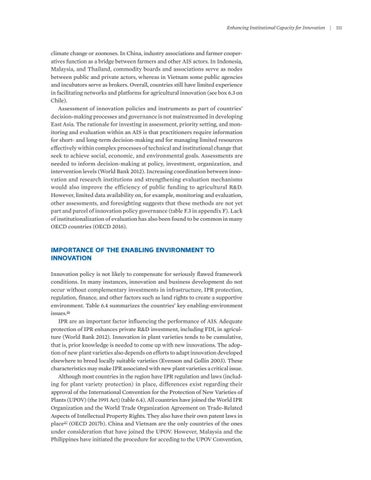Enhancing Institutional Capacity for Innovation | 111
climate change or zoonoses. In China, industry associations and farmer cooperatives function as a bridge between farmers and other AIS actors. In Indonesia, Malaysia, and Thailand, commodity boards and associations serve as nodes between public and private actors, whereas in Vietnam some public agencies and incubators serve as brokers. Overall, countries still have limited experience in facilitating networks and platforms for agricultural innovation (see box 6.3 on Chile). Assessment of innovation policies and instruments as part of countries’ decision-making processes and governance is not mainstreamed in developing East Asia. The rationale for investing in assessment, priority setting, and monitoring and evaluation within an AIS is that practitioners require information for short- and long-term decision-making and for managing limited resources effectively within complex processes of technical and institutional change that seek to achieve social, economic, and environmental goals. Assessments are needed to inform decision-making at policy, investment, organization, and intervention levels (World Bank 2012). Increasing coordination between innovation and research institutions and strengthening evaluation mechanisms would also improve the efficiency of public funding to agricultural R&D. However, limited data availability on, for example, monitoring and evaluation, other assessments, and foresighting suggests that these methods are not yet part and parcel of innovation policy governance (table F.3 in appendix F). Lack of institutionalization of evaluation has also been found to be common in many OECD countries (OECD 2016).
IMPORTANCE OF THE ENABLING ENVIRONMENT TO INNOVATION Innovation policy is not likely to compensate for seriously flawed framework conditions. In many instances, innovation and business development do not occur without complementary investments in infrastructure, IPR protection, regulation, finance, and other factors such as land rights to create a supportive environment. Table 6.4 summarizes the countries’ key enabling-environment issues.26 IPR are an important factor influencing the performance of AIS. Adequate protection of IPR enhances private R&D investment, including FDI, in agriculture (World Bank 2012). Innovation in plant varieties tends to be cumulative, that is, prior knowledge is needed to come up with new innovations. The adoption of new plant varieties also depends on efforts to adapt innovation developed elsewhere to breed locally suitable varieties (Evenson and Gollin 2003). These characteristics may make IPR associated with new plant varieties a critical issue. Although most countries in the region have IPR regulation and laws (including for plant variety protection) in place, differences exist regarding their approval of the International Convention for the Protection of New Varieties of Plants (UPOV) (the 1991 Act) (table 6.4). All countries have joined the World IPR Organization and the World Trade Organization Agreement on Trade-Related Aspects of Intellectual Property Rights. They also have their own patent laws in place27 (OECD 2017b). China and Vietnam are the only countries of the ones under consideration that have joined the UPOV. However, Malaysia and the Philippines have initiated the procedure for acceding to the UPOV Convention,

